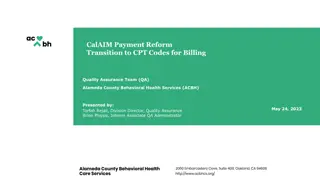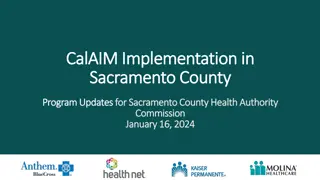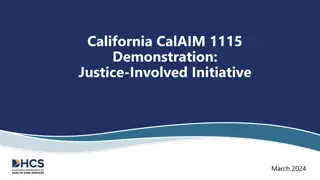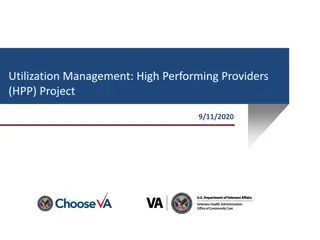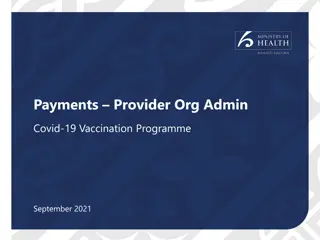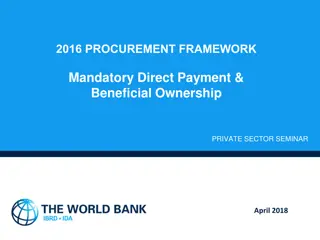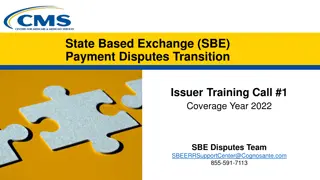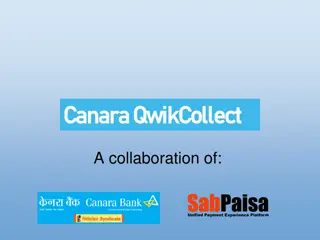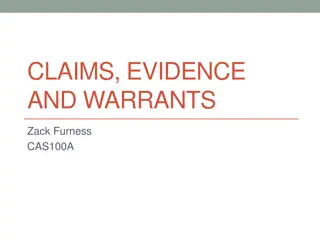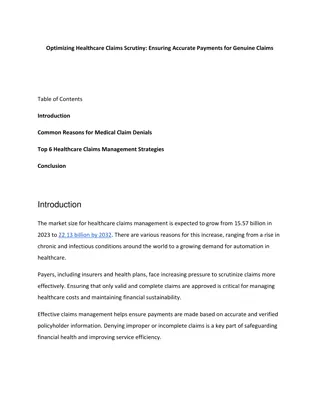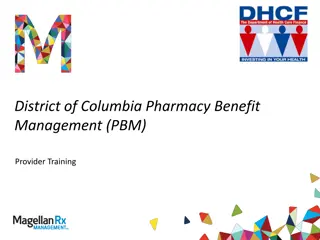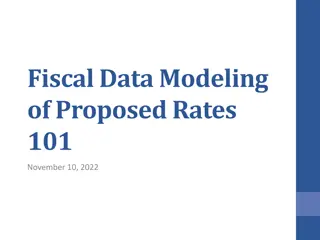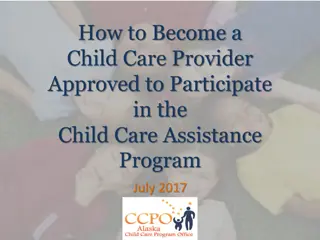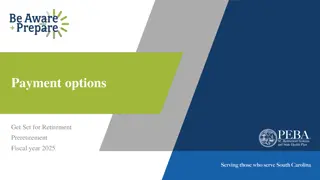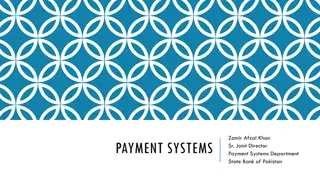Update on CalAIM Claims Payment Transition for ACBH Providers
Providers in Alameda County Behavioral Health Services (ACBH) are required to transition to using CPT codes for billing Medi-Cal due to the implementation of CalAIM. The transition is causing delays in claims payment processing, with ACBH working to align contract amendments with the new billing system. Providers are urged to review and sign contract amendments promptly to receive payments efficiently.
Download Presentation

Please find below an Image/Link to download the presentation.
The content on the website is provided AS IS for your information and personal use only. It may not be sold, licensed, or shared on other websites without obtaining consent from the author. Download presentation by click this link. If you encounter any issues during the download, it is possible that the publisher has removed the file from their server.
E N D
Presentation Transcript
CalAIM Payment Reform CPT Codes for Fee For Service Providers Quality Assurance Team (QA) Alameda County Behavioral Health Services (ACBH) Presented by: Amy Saucier, Clinical Review Specialist Supervisor Danielle Pence, Clinical Review Specialist September 6th and 11th, 2023
What Is Changing Claims Payment New Utilization Table CPT Code Key Concepts: Procedure Code Descriptions and Service Times Direct Patient Care Maximum Units Allowed Dependent On Codes: Add On and Supplemental Codes Lockouts and Modifiers Service Descriptions Clarification of Specific Services/Frequently Asked Questions New FFS Handbook Q&A Topics 2
What is Changing Effective July 1, 2023, providers will need to use CPT Codes when billing Medi-Cal. ACBH is sunsetting its existing billing system, InSyst, and claims processing system, eCura, and replacing it with SmartCare. Currently SmartCare Go-Live Date for FFS Providers is TBD; Communication will be forthcoming. 3
Claims Payment Due to delays in transitioning to the new SmartCare billing system, ACBH is experiencing challenges processing the contract amendments to align with the new CPT codes mandated by California Advancing and Innovating Medi-Cal (CalAIM) and processing the July 2023 claims. ACBH recognizes the hardship of payment delays and sincerely apologizes for the impact on our providers. ACBH is currently processing the FY 2023-24 contract amendments. If you have not received your amendment for signature by September 6, 2023, please contact your ACBH Contract Manager. Please review these contract amendments closely, as they contain your new rates. 4
Claims Payment (Continued) After you sign the contract, please submit the July claims using the new rates and procedure codes. If you have already submitted your July claims using the old rates and procedure codes, you must submit a new, updated claim. These claims will be prioritized and expedited according to the original submission date. The goal of ACBH is to process payments as efficiently as possible and within 45 days of the receipt of invoice, e.g., by September 15, 2023, for July services submitted by August 1, 2023. After this transition period, ACBH anticipates invoice processing time to return to the previous expedited schedule. 5
Requirements for Submitting New Claims When submitting new claims for dates of service on or after 7/1/23, providers will need to submit the following documents along with their claim: MH Registration Form - This form only needs to be included with the first claim for a client and when client information changes. If you have already submitted your July and August claims, you do not need to resubmit. For all claims from September onwards, ACBH will return claims that are not accompanied by this Client Registration Data form, with a 30-day resubmission deadline. MHS Update Discharge Out-Patient - For Annual Data and outpatient discharge. The forms can be found on the SmartCare Page of the ACBH Provider's website 6
Utilization Table and CPT Code Reference Guide ACBH has updated the two-page Utilization Table to include the changes to the CPT codes. Please use this as a guide for your claims. 8
CPT Code Basics: Procedure Code Descriptions and Service Times 11
Procedure Code Description with Set Times Some codes have set times associated with the service. In these situations, the services can be claimed once they reach the midpoint of the time associated with code. The Time Associated with Code column on the crosswalk shows the range of time that can be claimed using the code. For example, T1017Targeted Case Management has a 15-minute time associated with the code. The service cannot be claimed unless it lasts at least 8 minutes, which is the midpoint of 15 minutes. The midpoint doesn t apply to codes with time ranges, only to those with set times. For codes that do not have a specific time associated with the service, DHCS has assigned a 15-minute limit. 12
Procedure Code Description with Set Times (Continued) In some cases, there are multiple codes for the same service but each have a different time range associated with the code. SmartCare Procedure Code andSmartCare Procedure Code Description on the crosswalk will show the time associated with code. Time Associated with Code on the crosswalk shows the range of time that can be claimed using the code. For example, 90832 Psychotherapy 30 minutes w/Patient should be used when a service lasts from 16-37 minutes. 90834 Psychotherapy 45 minutes w/Patient should be used when a service lasts from 38-52 minutes. 90837 Psychotherapy 60 Minutes w/Patient should be used when a service lasts over 53 minutes. 13
Direct Patient Care Only the time it takes to provide direct services associated with a code can be claimed to the State. Direct Patient Care means time spent with: The patient for the purpose of providing healthcare The consultant/members of the beneficiary s care team (may include family) Direct Patient Care does not include travel time, administrative activities, chart review, documentation, utilization review and quality assurance activities or other activities a provider engages in either before or after a patient visit. 14
Maximum Units Allowed Dependent On Codes: Add On Codes Supplemental Codes 15
Maximum Units Allowed per Day Outpatient codes have a maximum number of units that can be billed per day. For example, only one unit, or one 15-minute 90791 Psychiatric Diagnostic Evaluation service can be billed per day. Maximum Units are per beneficiary, per service line. For example, if provider A bills for one unit of 90791, provider B can also bill for one unit of the same service on the same day. Add-On codes can be used to extend the time associated with a service. 16
Combined Aggregate Limits There are some SMHS services that are limited to a specific amount of time in a 24- hour period, according to California Code of Regulations. These include the following: Medication Support Services are limited to 4 hours (9 CCR 1840.372) Crisis Intervention Services are limited to 8 hours (9 CCR 1840.366) Crisis Stabilization Services are limited to 20 hours (9 CCR 1840.368) These are known as Combined Aggregate Limits. The Combined Aggregate is equal to the sum of time associated with all approved services in DHCS claim history provided to the same beneficiary, on the same day. Note: Please see the DHCS SMHS Billing manual for the table list of all the procedure codes and the time associated with each procedure code that SD/MC will use to calculate the combined aggregate. 17
Dependent On Codes Dependent On Codes can only be used in conjunction with another procedure code. These codes cannot be billed unless the provider first bills for the primary procedure to the same beneficiary, on the same date. There are two types of Dependent On Codes: Add on Codes: Add time to a primary procedure Supplemental Codes: Modify a procedure 18
Maximum Units and Defined Add On Codes When Maximum Units that Can be Billed for a service are limited, and the service has a short time frame associated with it, the service may need to be claimed with two procedure codes: the Primary code and an Add On code, to extend the time associated with the service. Add On codes cannot be billed unless the provider first bills for the primary procedure to the same beneficiary, on the same date. Some services have their own Add-on codes. For example, if more than an hour of psych testing is provided, code 96130 Psych Testing Eval, First Hour can be used along with the Add on Code of 96131 Psych Testing Eval, Ea Add l Hour. 19
Maximum Units and G2212 For services that do not have established Add On Codes, G2212 can be used as the Add On Code. This code has a 15-minute limit and can be claimed once it s midpoint of 8 minutes is reached. For example, 90791 Psychiatric Diagnostic Eval has a 15-minute time associated with code, and only one unit of this code can be claimed each day. Since 90791 doesn t have its own Add On Code, G2212 would be used along with 90791 if the service lasts more than 15 minutes. In this example, once the evaluation lasts 23 minutes or longer (15 minutes for the 90791 plus 8 minutes as midpoint of G2212), G2212 can be used to claim for the additional time.
Lockouts Some codes cannot be billed together, and others can only be billed together in special circumstances. Sometimes lockouts can be overridden with a modifier. Lockouts that can be overridden are indicated with either one or two asterisks in the lockout column of the Crosswalks. In this example, CPT code 90791 cannot be claimed with 90792 and there are no modifiers that can be used to create an exception, since there is no asterisk on 90792 in the Lockout column. Lockout over-riding modifiers only apply to CPT codes, not HCPCS codes. CPT code 90791 also cannot be claimed with CPT code 90839 and 90840, however, since there is an asterisk on these codes, an appropriate modifier can be used to override this Lockout. SmartCare does not add lockout modifiers but will prompt users to add them when necessary. 22
Modifiers Modifiers provide a way to indicate that a service or procedure performed was altered by some specific circumstance but not changed in its definition or code. Modifiers will not impact how much a service is reimbursed but may impact how a service should be billed and/or who pays for the service. SmartCare is being programmed to apply most modifiers automatically or to prompt the user to apply the appropriate modifier. Information will be communicated to providers about this SmartCare functionality, once it becomes available. Modifier Definition When to Use HQ Group Setting Use this modifier to indicate that a therapy service was provided in a group setting. Examples: HL Intern Use this modifier when the service was performed by a registered, pre-licensed MH professional working in a clinical setting under supervision.
Clarification of Specific Service Codes and Frequently Asked Questions 31
How do we claim for group services? Group services can be claimed using specific CPT Codes and if needed, can be extended using G2212 plus the HQ Modifier. Claims should be submitted separately for each beneficiary receiving group therapy as follows: Enter total face-to-face time on each beneficiary claim. Enter total travel time for the service on one of the client service records OR divide evenly between each participant in the group. Enter individual documentation time for each client separately on each participant s service. Service Code Discipline Group Psychotherapy 90853 PhD/PsyD, LCSW, LMFT (Licensed or Waivered) 32
What CPT codes can be used to connect clients to services? The Reference Guides provided can be sorted by Service Category. Search for Referral Codes for SMHS, or Care Coordination Codes for DMC-ODS, to find appropriate Brokerage/Case Management services. Targeted Case Management is a service that assists a beneficiary to access needed medical, educational, social, prevocational, vocational, rehabilitative or other community services. Service Code Discipline Targeted Case Management T107 LP, PA, Pharma, Psy, LCSW, MFT, RN, NP, LPCC, AOD 33
What code can be used for Collateral session? Although there is no longer a distinct code for Collateral Services, providers can still bill for these services. Collateral services can be a component of many types of services, including but not limited to, Assessment, Rehabilitation, Plan Development, Peer Support, Targeted Case Management, Crisis, or Therapeutic Foster Care. Providers should select the service code that most closely fits the service provided and make clear in a Progress Note that the service was provided to a collateral contact. Some procedure code descriptions clearly describe the service as occurring with the client present. Those procedure codes should not be selected for collateral sessions. 34
Collateral Services- Continued CPT code 90887 "Interpretation or Explanation of Results of psychiatric of other medical procedures to family or other responsible persons is identified as a possible collateral code on the Procedure Code Table. However, 90887 is a supplemental code, so it can only be used along with another code. It is also linked to specific Dependent On codes and is only 15 minutes. Since 90832 (psychotherapy with patient for 30 minutes) is one of the Dependent On codes for 90887, here is how it can be used: If you have a 30 minute therapy session with the client and then meet with the family alone to go over your assessment of the client's needs for 15 minutes, you would bill for 30 minutes using 90832 and add the supplemental code of 90887 for 15 minutes of time spent with the family. 35
New MHP FFS Handbook The new FFS Provider Handbook has been published on the MHP FFS Page on the Provider s Website. It includes a lot of helpful information including the new process to connect a client to Mental Health Services without a referral from ACCESS. Please review it carefully. Feel free to reach out if you have any questions. 37
Respond to questions from current training Review questions from previous training Follow up questions sent to QATA@acgov.org Questions and Answers 38
For questions about the presentation, contact QATA@acgov.org. 39



